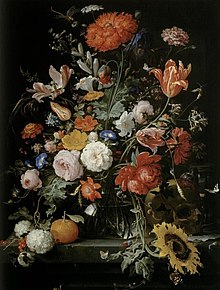Abraham Mignon
Abraham Mignon (born June 21, 1640 in Frankfurt am Main , † March 27, 1679 in Utrecht ) was a German - Dutch painter .
Life
His father, a merchant , brought him into the care of the still life painter Jacob Marrel at the age of 9 , who then took him to Holland in 1664. In Utrecht, both were accepted into the St Lukas Guild, a painters' association, from 1669. Mignon then worked until 1672 as an assistant in the workshop of the still life specialist Jan Davidszoon de Heem , who had strongly influenced his painting style, and who, however, unified him with his opulently structured arrangements of flowers in detailed depictions with splendid coloring against a dark background assured their own, unmistakable style.
In 1675 he married the daughter of the painter Cornelis Willaerts († 1666), with whom he returned to Frankfurt in 1676. There he taught, among other things, Maria Sibylla Merian , whose mother was married to Jacob Marrel, and whose name is still internationally renowned among botanists and numerous flower lovers because of its meticulously depicted and lifelike images.
plant
Mignon's work consists exclusively of still lifes, the motifs with flowers, fruits and birds etc. a. demonstrate. Stylistically, his works are characterized by the brilliance of their colors and opulently designed arrangements. A frequently used picture structure composes a white or red rose in the middle of the picture against a dark background, around which he then twines his floral subjects, often interspersed with small animals (squirrels, birds, fish, insects). As with all Dutch and Flemish painters, the work not only strives for a reproduction that is as true to detail as possible in an atmospheric light, but the picture also refers to the transience of all earthly splendor ("vanitas").
His painting was highly valued at the Saxon Court under August II at the time, which explains why some of his works can still be admired in the Old Masters Picture Gallery in Dresden today. The French royal house under Louis XIV was also one of his customers, who ordered some of his masterpieces, which speaks for the painter's fame. Mignon's masterfully painted flower arrangements are represented in almost all major European collections, but especially in the Rijksmuseum Amsterdam and are among the flower, fruit and poultry paintings of the 17th century that were popular then as now and in great demand on the art market.
literature
- Magdalena Kraemer-Noble: Abraham Mignon. 1640-1679 . Imhof publishing house, Petersberg 2007, ISBN 9783865681447
- RvLutterfelt: Schilders van stilleven. Nards. 1947.
- W. Prince: Painting of the Historisches Museum Frankfurt / M., 1957.
Web links
- Mignon, Abraham in the Hessian biography
- Literature by and about Abraham Mignon in the catalog of the German National Library
- Abraham Mignon in the Rijksmuseum Amsterdam
- Work of art of the month November 2016: Still life with a fruit basket on an oak tree , Abraham Mignon around 1670 , Museum Kunstpalast , video lecture by Bettina Baumgärtel , on YouTube, accessed on November 8, 2016
| personal data | |
|---|---|
| SURNAME | Mignon, Abraham |
| BRIEF DESCRIPTION | German-Dutch painter |
| DATE OF BIRTH | June 21, 1640 |
| PLACE OF BIRTH | Frankfurt am Main |
| DATE OF DEATH | March 27, 1679 |
| Place of death | Utrecht |

